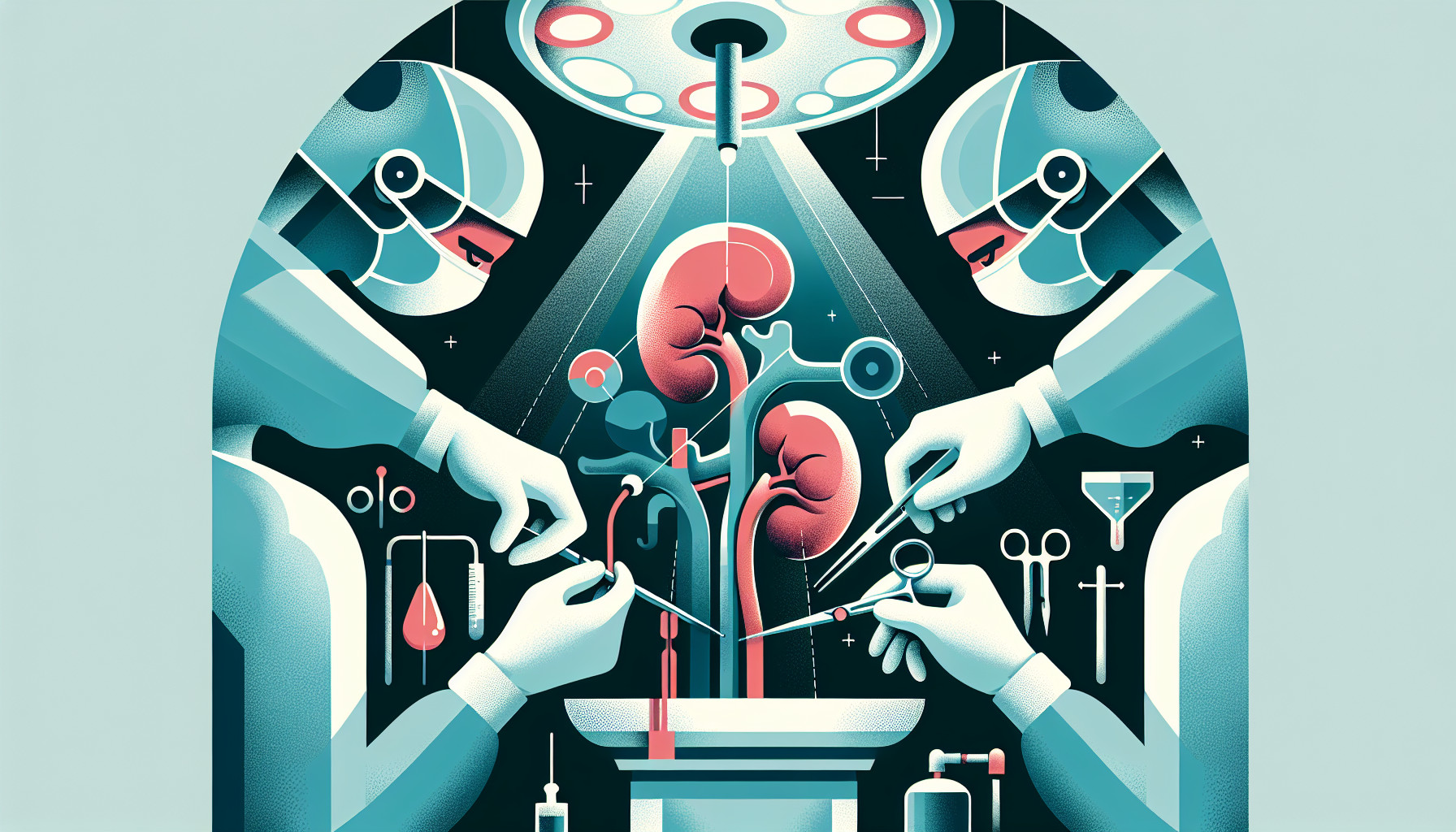Our Summary
This research paper reviews the safety and feasibility of a specific type of kidney removal surgery, known as laparoscopic living donor nephrectomy, in which a kidney is removed from a living donor for transplantation. The study particularly focuses on the removal of the right kidney and kidneys with multiple renal arteries, which are considered more challenging due to complex vascular anatomy.
The research involved a comprehensive review of previous studies, comparing this type of surgery on right kidneys and kidneys with multiple renal arteries to the same procedure on left kidneys and kidneys with a single renal artery. The researchers looked at factors such as operation time, rate of conversion and transfusion, donor recovery time, and success rate of the transplanted kidney.
The results from 16 studies on right kidney removal and 12 studies on removal of kidneys with multiple renal arteries showed that these more complex procedures have similar safety and feasibility to the less complex ones. The researchers concluded that right kidney and multiple renal artery removal can be performed with similar safety and success rates as left kidney and single renal artery removal.
FAQs
- What is the focus of this research paper on laparoscopic living donor nephrectomy?
- What factors were considered in comparing the complexity of different kidney removal surgeries?
- What were the conclusions of the study on the safety and feasibility of right kidney and multiple renal artery removal surgeries?
Doctor’s Tip
One helpful tip a doctor might give a patient about laparoscopic nephrectomy is to follow all pre-operative instructions provided by the medical team. This may include fasting before surgery, stopping certain medications, and possibly undergoing some pre-operative testing. Following these instructions can help ensure a successful surgery and smooth recovery process.
Suitable For
Patients who are typically recommended for laparoscopic nephrectomy include:
Living kidney donors: Laparoscopic nephrectomy is commonly performed on living kidney donors who are willing to donate one of their kidneys to a recipient in need of a kidney transplant. This procedure allows for a minimally invasive approach to removing the kidney, leading to faster recovery times and reduced postoperative pain for the donor.
Patients with renal tumors: Laparoscopic nephrectomy may also be recommended for patients with renal tumors that are localized to one kidney. Removing the affected kidney through laparoscopic surgery can be an effective treatment option for these patients.
Patients with kidney stones: In some cases, laparoscopic nephrectomy may be recommended for patients with large kidney stones that are causing symptoms or complications. Removing the affected kidney through laparoscopic surgery can help alleviate pain and improve kidney function.
Patients with polycystic kidney disease: Laparoscopic nephrectomy may also be recommended for patients with polycystic kidney disease, a genetic disorder characterized by the growth of numerous cysts in the kidneys. Removing one or both kidneys through laparoscopic surgery can help alleviate symptoms and improve quality of life for these patients.
Overall, laparoscopic nephrectomy is a safe and effective surgical option for a variety of patients with kidney-related conditions. It is important for patients to discuss their individual case with their healthcare provider to determine if laparoscopic nephrectomy is the most appropriate treatment option for them.
Timeline
Before laparoscopic nephrectomy:
- Patient undergoes initial consultation with a healthcare provider to discuss the need for kidney removal.
- Patient undergoes pre-operative testing such as blood tests, imaging studies, and possibly a biopsy.
- Patient receives instructions on how to prepare for surgery, including fasting and medication restrictions.
- Patient discusses anesthesia options with the anesthesiologist.
During laparoscopic nephrectomy:
- Patient is placed under general anesthesia.
- Surgeon makes small incisions in the abdomen and inserts a laparoscope and surgical instruments.
- Surgeon identifies the kidney and carefully removes it from the body.
- The kidney is then prepared for transplantation if it is a living donor nephrectomy.
After laparoscopic nephrectomy:
- Patient wakes up in the recovery room and is monitored for any complications.
- Patient may experience pain and discomfort at the incision sites.
- Patient is given instructions on how to care for the incisions and manage pain.
- Patient is discharged from the hospital and given follow-up instructions for recovery at home.
- Patient may experience fatigue, limited mobility, and other side effects during the recovery period.
- Patient follows up with the healthcare provider for post-operative care and monitoring of kidney function.
What to Ask Your Doctor
- What are the potential risks and complications associated with laparoscopic nephrectomy in general, and specifically with the removal of a right kidney or a kidney with multiple renal arteries?
- How experienced are you in performing laparoscopic nephrectomy, especially in cases involving right kidneys or kidneys with multiple renal arteries?
- What is the expected recovery time for me as a living donor after undergoing laparoscopic nephrectomy?
- How will my remaining kidney function be affected after the removal of one kidney?
- What is the success rate for transplanted kidneys from living donors who have undergone laparoscopic nephrectomy?
- Will I need to make any lifestyle changes or have ongoing medical monitoring after the surgery?
- What are the alternatives to laparoscopic nephrectomy for kidney removal, and why is this the recommended option for me?
- How long can I expect to stay in the hospital after the surgery, and what is the post-operative care plan?
- Are there any long-term effects or complications that I should be aware of after undergoing laparoscopic nephrectomy?
- Are there any resources or support services available for living donors who have undergone laparoscopic nephrectomy?
Reference
Authors: Broudeur L, Karam G, Chelghaf I, De Vergie S, Rigaud J, Perrouin Verbe MA, Branchereau J. Journal: World J Urol. 2020 Apr;38(4):919-927. doi: 10.1007/s00345-019-02821-8. Epub 2019 May 25. PMID: 31129713
